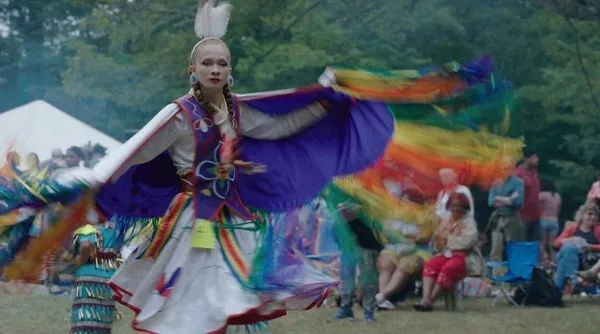Eye For Film >> Movies >> Being Thunder (2021) Film Review
Being Thunder
Reviewed by: Jennie Kermode

Lately there have been a lot of assertions in the media to the effect that the concept of there being more than two genders, male and female, is a new invention, something thought up in the US or Europe which is becoming a fad. On the contrary, the idea is an ancient one. Look at the whole span of world cultures across history and it's actually having a binary system that's rare. Europe has, however, been very successful at exporting its culture in the wake of its conquests, to the point where, in many places, people have lost sight of their own traditions and now view gender through a European lens, even going so far as to assume that revivals of their older approaches are in fact colonialist imports. This affects the lives of individuals like Sherenté, a member of the Narragansett tribe who faces social exclusion where in the past being two-spirit - understood as having both male and female spirits - would have been celebrated and accorded its own specific social role.
With the the support of Sherenté's family, Stephanie Lamorre filmed this documentary over several months which included coming-of-age milestones like applying for college. Naturally this meant that her subject had a lot of other things to focus on, but gender has a way of getting into everything. The biggest issue here is dancing, an important part of Narragansett community life. We follow Sherenté through a long fight for permission to dance in a female role. Getting up close to film some of the dancing, Lamorre captures something of the atmosphere of the pow wows she attends. Her different narrative angle makes it easier for her to convey the weight of meaning that they carry.
To be two-spirit is different from being transgender as most people understand it. Lamorre films Sherenté putting on make-up in front of a mirror, a shot which appears in almost every film ever made about trans women, but the make-up is very different in style and in its traditional meaning. There's a suggestion that the community would, in fact, be more accommodating if Sherenté had surgery and could thereby be understood in terms of the modern model. Over time, what began out of a personal need for acceptance morphs into something else: an effort to reconnect the community with aspects of its history that have been lost.
Gender and colonialism are closely connected, with Europeans often striving to export the idea that men and women are very different from (but complementary to) one another, and that nowhere is this more visible that among white people, as a means of shoring up supposed white superiority. With that in mind, it's easy to see why they sought to eliminate multi-gender traditions, but why were they so successful with the Narragansett when other tribes never entirely succumbed to this? That, suggests Sherenté, is simply an accident of geography. Rhode Island was one of the first places the Europeans settled: they had two centuries in which to work on people there before they made it to the West Coast. From that perspective, it's a wonder that any traditions have survived, and we can see how much is at stake.
From a technical perspective, the film is fairly basic. Key moments are captured with a single handheld camera which is sometimes shaky. Doing so much of it on her own, however, has enabled Lamorre to develop a real intimacy with Sherenté, the family and members of the wider community. Through her focus on what might seem like a narrow issue, she mines a rich vein of history. There are still vanishingly few films which touch on Native American issues at all so this has significant value, but it's also a history with numerous points of relevance for colonised peoples elsewhere in the world.
Reviewed on: 12 Jun 2021
















